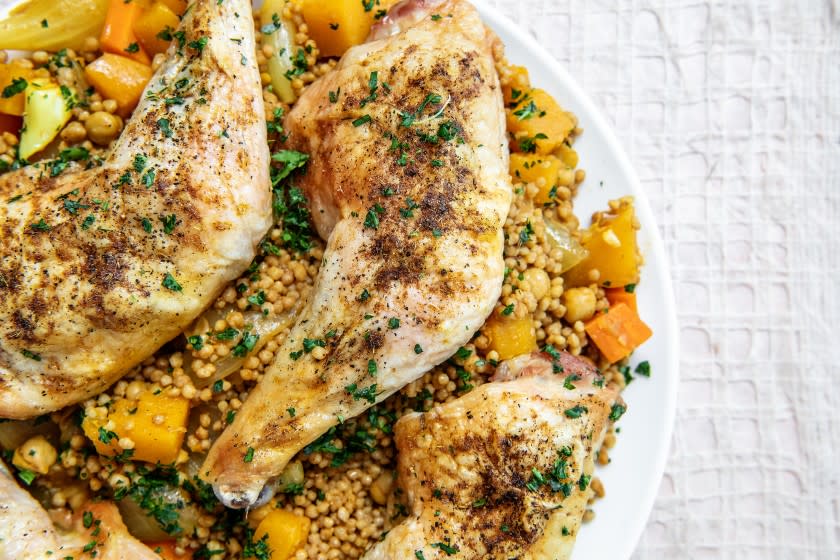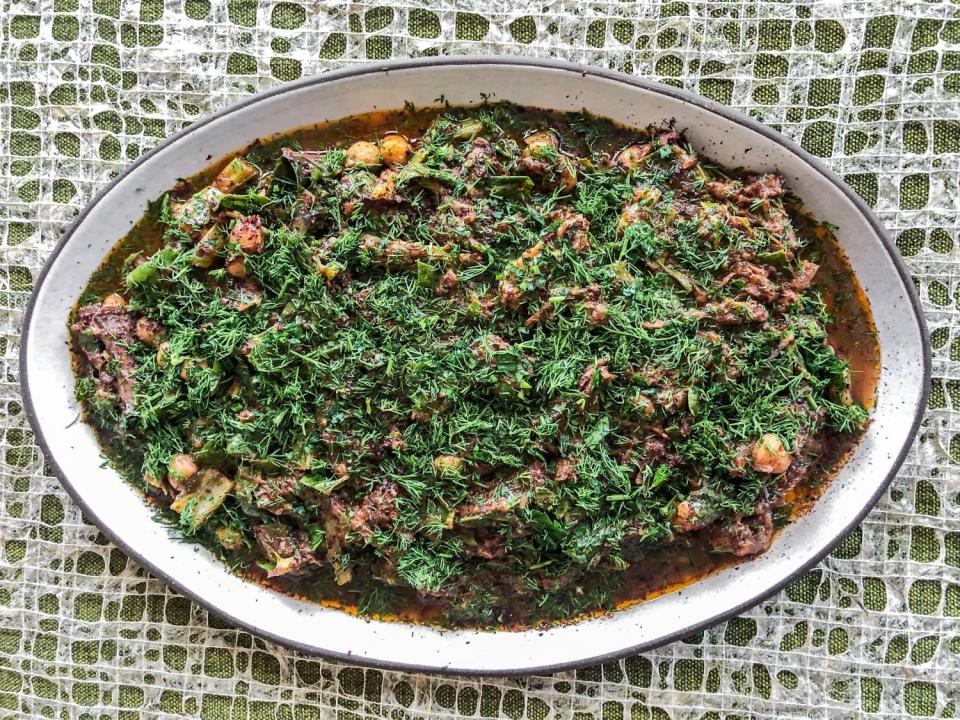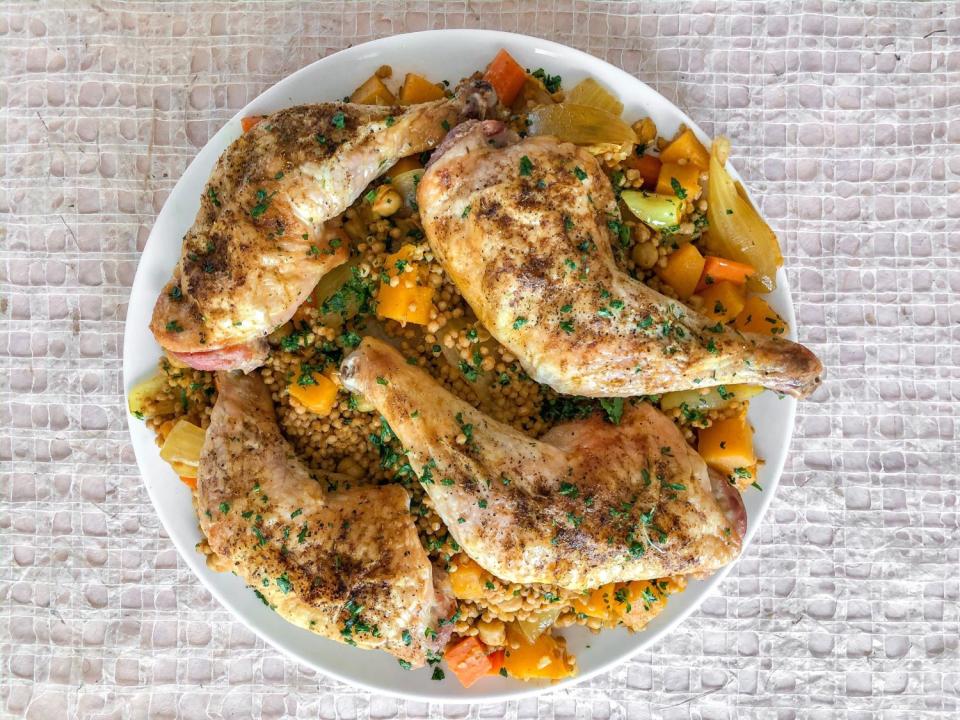Palestinian cookbooks help preserve a culture's identity

The deep red of ground sumac brings to mind the ripest strawberry, though the spice’s flavor veers lemony and tart — like a floral vinegar distilled into powder.
Its brightness defines sumaqqiyeh, a Palestinian stew with origins in Gaza City, where it’s often served at Eid al-Fitr celebrations. Beef or lamb simmers with chickpeas and chard. In addition to sumac, a core Gazan trinity of garlic, green chile and dill blazes through the pot; they’re added near the end of cooking so their flavors jump. Red tahini, a local specialty that gains its color by roasting the sesame seeds before grinding them, traditionally enriches the dish.
Palestinian chef Sami Tamimi uses oxtails for the lush version of sumaqqiyeh in his new cookbook “Falastin.” The oxtails cook for four hours, until their meat all but flops off the bones. Cumin, cinnamon and baharat (a spice blend warmed by peppercorns, cloves, cardamom, allspice and nutmeg) infuse the tomato-laced broth. His recipe advises adding the greens at the finish line, heating them only until wilted, and suggests generous garnishes of sumac, chopped dill and sliced chiles.
“I had in my head that you should deliver something beautiful to people,” Tamimi said recently by phone. “You spend all this time slow-cooking meat and it turns out beigey-brown, not a pretty dish.” The herbs, for him, are vital cosmetology. “It’s delicious, though, and it felt important to include it in the book.”
Aesthetics matter to Tamimi. He’s the executive chef and a partner behind the Ottolenghi brand in London; he’s worked with Yotam Ottolenghi since the two opened the first Ottolenghi deli in 2002. Their bowls of pomegranate-jeweled salads and tiered towers of meringues and mini-cakes begat four delis and two full-service restaurants, Nopi and Rovi.

The brand’s success also sired a string of cookbooks, beginning with vegetable-focused “Plenty” published in 2010. They helped ingratiate a light-touch use of ingredients common to many cuisines across the Middle East — tahini, fava beans, sprinkles and swoops of crushed pistachios and yogurt as savory garnishes — into the broader British and American repertoires. The za’atar and labneh croissants featured at Proof Bakery in Atwater Village? The lamb neck shawarma at Bavel in the Arts District? The Ottolenghi influence laid the tracks for their arrival in our food culture.
Ottolenghi and Tamimi wrote two books together: “Ottolenghi: The Cookbook” and “Jerusalem,” the 2012 bestseller centered on the city where both chefs were born; Tamimi grew up in a Muslim family in East Jerusalem and Ottolenghi, who is Jewish, was raised in West Jerusalem.
Their book includes an often-quoted line of hope about the dish that has most come to symbolize Middle Eastern food for the world: “It takes a giant leap of faith, but we are happy to take it — what have we got to lose? — to imagine that hummus will eventually bring Jerusalemites together, if nothing else will.”
In “Falastin,” published this month in the United States and written with longtime Ottolenghi collaborator Tara Wigley, Tamimi steps forward to more forthrightly proclaim his Palestinian heritage. The book is an embrace of — and reckoning with — his homeland’s complexities.
He’d tried sumaqqiyeh several times in his travels over the years, for example — most recently at his sister’s house in Jerusalem. Gaza City sits on the coast less than 50 miles southwest of her home, but Tamimi couldn’t visit the dish’s place of origin. “Falastin” lays out the reasons. Israel seized the Gaza Strip during the Six-Day War with Egypt in 1967; the Israeli government officially withdrew its presence from Gaza in 2005, but in escalated cross-border violence with Hamas, the Palestinian militant Islamist political organization, Israel and Egypt restricted movement at the Gazan borders with blockades. Neither people nor goods can enter or exit freely. “The Gaza Strip is one of the world’s most densely populated places,” states an essay in the book. About 25 miles long and 6 miles at its widest, with a population of nearly 2 million, “it’s often described as the world’s ‘largest open-air prison.' ”
The discussion focuses on fishing zone restrictions and an ineffective sewage system; both have contributed to the derailing of Gaza’s once-thriving seafood industry.
Other discourses throughout the book address questions of land ownership, checkpoint realities, and the destruction of ancient West Bank olive groves to make way for Israeli settlements. Tamimi and Wigley also spotlight food champions like Vivien Sansour, a small-farm advocate and founder of the Palestinian Seed Library dedicated to heirloom vegetable preservation.

“Writing these stories — indeed writing a Palestinian cookbook — feels like a big responsibility,” they say in the intro. “All the food and hospitality that a recipe book celebrates must be served, in the case of Palestine, against a very sobering backdrop.”
The book is gorgeous, full of sumptuous-looking dishes photographed in the style that brings the Ottolenghi brand enduring success: a basket of chickpeas flecked with tiny Aleppo chile flakes, bowls of mint-strewn figs, pasta suspended in yogurt and scattered with breadcrumbs. There are images of robust markets and mountainside villages and boys joyfully jumping off a wall into the sea.
But some messes can’t be disguised by food styling or ignored in favor of prettier views, and “Falastin” holds some space for hard realities.
***
Tamimi’s foray into his culinary heritage follows other notable Palestinian cookbooks published over the last decade — each of them proclamations of identity and, in their individual voices, records of a dispersed, threatened culture.
In 2012 “The Gaza Kitchen” opened wide the micro-regional cuisine from the now-impoverished region; for millennia the Strip was a port along the spice routes. Laila El-Haddad, who wrote the book with Maggie Schmitt, called it a “documentary cookbook.” Recipes for cardamom-scented shrimp, stingray soup and avocado salad (a vestige of 1980s-era Israeli settlements in Gaza) share pages with profiles of community-minded cooks and farmers and frank treatises on the political landscape. Among them is “On Olive Oil,” about the destruction of olive groves, which turned olive oil from a staple with centuries of history into a luxury that El-Haddad said only the wealthy can afford to cook with.
In her two books, “Palestine on a Plate” and “Baladi,” London-based chef Joudie Kalla writes about dishes reflecting Bilad al-Sham, or Greater Syria, now more commonly called the Levant, and also the Palestinian diaspora impelled after Israel was established as a nation in 1948. She has never set foot on historic Palestinian ground. Neither have her parents. Her grandparents, on both sides of her family, fled Palestine to Syria as refugees in 1948; Kalla grew up between Qatar and Britain.
For three years she ran a successful London restaurant called Baity Kitchen, opened in 2010. When she wanted to record the menus she was cooking — stuffed vegetables, spiced lamb and rice, breads of many shapes, dishes recounted by her mother and many aunts — she gathered them on an app but struggled to find a publisher willing to print a book that included the word “Palestine” in the title.
“The feedback was: We feel uncomfortable talking about Palestine without talking about Israel,” Kalla said by phone. “Why do Palestinians have to be eternally tied with Israelis now? I’m not anti-Semitic. But Palestinians are being deleted. That’s the main thing. Food is how we remember who we are.”
Reem Kassis, author of “The Palestinian Table,” lives in Philadelphia and was raised in East Jerusalem: Her father, a Christian, came from a northern mountain village; her mother, a Muslim, grew up in a rural town known for its orchards. Her book, released in 2017, is a memory palace of family recipes that spans the region.
Kassis focuses the book on food and kin; in an opinion piece she wrote in February for the Washington Post, she gave voice to the objections raised by many Palestinians over the notion of “Israeli cuisine.” “By and large, the dishes that make up the Israeli ‘national food’ repertoire (hummus, falafel, msabaha, baba ghanoush, knafeh) were learned from the Palestinian population,” she wrote. “In many restaurants and cookbooks, Israelis have no problem including such items as ‘Yemeni schug,’ ‘Iraqi sabich’ or ‘Tunisian salad.’ But the absence of the word ‘Palestinian’ from their menus and books is a glaring omission. As many Israeli academics and food writers themselves have pointed out, the word ‘Palestinian’ is still considered by many Israelis as a threat to their existence.”
It’s the forceful conflation of local traditions with which Kassis and the other authors particularly struggle. “Fusion is actually not new to the Middle East/Arab world,” Kassis told me recently. “As the ‘cradle of civilization,’ centuries of migration, occupation and trade have meant that Palestinian cuisine was regularly evolving and being influenced by just as much as it influenced others since the dawn of history. We see the mark of history not only through a region’s architecture, music and literature but through its cuisine. When we see that history being refuted or threatened, that’s when the attachment to it and desire to preserve it increases.”
***
The United States has only a handful of restaurants that identify themselves distinctly as Palestinian: Reem’s California and Beit Rima in San Francisco, Qanoon in Manhattan and Tanoreen in Brooklyn are among the most widely known. In Southern California, Palestinian immigrants Mike Hawari and Nesrine Omari opened Kareem’s in Anaheim in 1996; around them blossomed other businesses that would eventually be known as the Little Arabia district. Their kitchen rolls out Levantine comfort foods: hummus, fattoush, falafel or grilled chicken wraps, grape leaves and breakfast staples like fatteh, chickpeas with fried khubz (pita) in yogurt sauce.
Nearby, Asem Abusir runs Knafeh Cafe, serving the version of knafeh — a pastry of crisp, broken strands of kataifi dough layered with salty, molten cheese — that’s a signature of his hometown, Nablus, in the northern West Bank.
Most of us will need to turn to the home stove to taste the profoundest contributions of Palestinian gastronomy. As an ardent student of the Middle East’s cuisines, I wanted to eat Palestinian dishes as Palestinian cooks intended them.

Which dishes from the last decade's worth of Palestinian cookbooks hew most closely to the national identity? Tamimi said he fields the question often, usually through the lens of Israel and appropriation. As a writer who absorbs food culture largely through restaurants, I also was curious about specificity from the broader Levantine perspective. In “Falastin,” for example, I recognize from the menus of Lebanese restaurants balila (garlicky, lemony stewed chickpeas), koussa bil laban (summer squash filled with spiced rice and ground meat and served in yogurt sauce) and the ubiquitous chopped “Arabic salad” starring tomatoes and cucumbers. The book mentions mansaf, a lamb stew flavored with jameed (discs of dried goat or sheep yogurt) or kishk (a variation that can include bulgur); it’s known as a specialty of Hebron, a city in the southern West Bank, and also as the national dish of Jordan.
When I asked, Tamimi had suggestions for recipes he deemed wholly intrinsic to the Palestinian lexicon. Other Palestinian authors echoed them in conversations and in their books. It struck me in preparing them that each of them are feasts unto themselves — foods for a group, their generosity inherent and deliberate.
Sumaqqiyeh was the first dish Tamimi mentioned. The dense richness of the deboned oxtail meat paid off for its hours of simmering; the finishing overlay of herbs and the maximum brightness of flavors reconfirmed why his and Ottolenghi’s style of cooking have left so many devotees spellbound. A delicious, true-minded and less time-consuming version in El-Haddad and Schmitt’s “The Gaza Kitchen” — and another wonderful take in “Zaytoun,” a Palestinian cookbook by author and human rights activist Yasmin Khan — added toasted sesame oil to simulate the flavor of red tahini, which is all but impossible to find outside Gaza.
Sumac’s lemony sharpness also balances the warmer spices in musakhan — roast chicken and onions originally doused with olive oil and piled on flatbread baked over pebbles that lined a taboon (clay oven). At olive harvest time in autumn, the dish was consumed to taste and assess the year’s first oil pressings. I used sheets of crisp Arabic bread purchased at Kozanian’s Ranch Market in Glendale, a favorite Los Angeles-area source for Middle Eastern ingredients. Eating the dish by hand — composing bites of bread, chicken and onion swiped through pools of oil and bowls of Greek yogurt — as Tamimi instructs, is a tactile pleasure.
Maqlubeh means “upside down” in Arabic; the name refers to a celebration dish of rice, lamb and vegetables tiered in a pot and then flipped over dramatically onto a platter, where it (hopefully) holds together as a showpiece savory cake. Tamami puts forth an extravagant maqlubeh, a gilded affair with fava beans, butternut squash and lamb neck meat, stained with turmeric, scented with dried limes and garnished with pine nuts and almonds.
Kozanian’s didn’t stock maftoul, a Palestinian cousin to couscous, but Cookbook in Echo Park and Highland Park does, and it can easily be ordered online from Canaan, a company that works with Palestinian farms and also sells olive oil from the region. Maftoul is a combination of bulgur and whole wheat flour sprinkled with water and hand-rolled into pearls and dried. When cooked, each sphere is beautifully distinct and freeform.

I made Tamimi’s maftoul: Carrots and butternut squash thrummed extra sweet against the pearls’ earthiness; the dish was fragrant with cumin, coriander and cinnamon and crowned with roasted chicken. My Palestinian friend Khaled studied the results thoughtfully.
“My family would have gone even harder on the spices,” he said. Then he beamed. “But yeah. This tastes … right.”
Dessert that night was Tamimi’s recipe for the knafeh from Nablus; he combines mozzarella, ricotta and feta for an approximation of the traditional Palestinian cheese. After baking, the pastry soaks in syrup perfumed with orange blossom water; crushed pistachios reinforce the crunch. Khaled and I had been to Knafeh Cafe shortly before the shutdown; we talked again about the differences between “crisp” knafeh like this one and a “soft,” stretchy-gooey variant popular in Lebanon. He texted his parents in Dubai about the variations. Eventually we scraped our plates in happy silence.
***
Approximating a local cheese for knafeh Nabulsayeh; scenting maqlubeh with dried limes, which are most closely associated with Iranian cuisine; using cheffy cuts of meat like oxtails and lamb neck for classic feast dishes: In “Falastin” Tamimi asserts a Palestinian identity that is both national and individual. Recipes can be recorded as evidence of a people — as stories, as archives for posterity, as testimony — but total authenticity is a fable when any cuisine travels beyond its origins. How he chooses to assert tradition and innovation is his right.
Across continents and cuisines, current discussions around food’s role in society center not only around who is offered a seat at the table but also on how people can claim complete agency over tables altogether. Each of the recent cookbooks written by a Palestinian living in diaspora affirms Palestine’s history and facilitates the evolution of its cooking in the wider world.
For Tamimi, a chef with a global brand who is enmeshed in the daily operations of running restaurants, tinkering is a given. “I love the tradition. I also want to see to the future,” he said plainly of Palestinian cooking. “I don’t cook like the old days. I cook in a modern way.” His Gazan shrimp stew is dolloped with cilantro pesto. The fiery Levantine condiment called shatta dresses baby gem lettuces.
Cultural fluidity also feels innate in Kalla’s recipes. In “Baladi” she traces a stew of pasta and lentils flavored with tamarind and pomegranate called harak osba’o (the phrase translates as “he’s burnt his finger” in Arabic) to Syria but notes its similarity to a Gazan dish called rummaniyeh (the word means “pomegranate-y”). A dish in “Palestine on the Plate” of cod with saffron, lemon and orange united one of her mother’s recipes with a request from a customer at her London restaurant.

“They’re not history books, in that sense,” Kalla said. “We want people to see who we are today.”
El-Haddad, author of “The Gaza Kitchen,” lives in Maryland; she was born in Kuwait to parents who grew up in different corners of Gaza. She used her desire to record disappearing Gazan culture to find her voice.
“For years, I thought, 'Who am I to be an authority on Palestinian food?' ” she said. “I felt nervous about owning my narrative. But no, it’s all of these different kinds of unique stories and backgrounds that create the mosaic of Palestinian identity.”
For her the evolution of Palestinian cuisine is part of the process of its reclamation. “I may not have grown up cooking these foods at their source, but this is still my cuisine. I know now not to let anyone interpret for me what it means to be Palestinian. I may not have ever visited Palestine but I’m Palestinian.”
Kassis is working on her second book, about modern Arabic cooking, and found examining the past — how recipes evolved in Palestine and the surrounding regions — crucial to giving shape to the notion of a people and its food. “That’s where cookbooks come into play. They document or give a snapshot of the current culinary landscape and in so doing preserve it for future generations.”
But documentation alone, she found, doesn’t do justice to a cuisine or place it in the most illuminating framing. “So I went down a path that traced the evolution of these foods from the start of their recording. This way, we can acknowledge the contribution of other cultures to our cuisine, of the impact of new lifestyles on how we cook, while still celebrating and preserving the history and traditions that gave rise to those dishes.”
That’s what is collectively striking about these cookbooks and their authors: They assert, each in their own way, identities large enough to be inclusive but also intimate enough to give us a real sense of who they are. Chronicles of oppressions and dreams for better lives don’t exist separate from the recipes.
In their lists of ingredients and sets of instructions they invite us into the soil of their ancestors. We eat garlic, chile, dill and tahini in a meat stew and place a pin on the map: Gaza. One writer tells us to be sure to sprinkle parsley over Palestinian maftoul before serving, while another simply encourages us to ladle brothy portions into bowls and dig in. Either way, the pearls of wheat and bulgur pass our lips like consonants and roll over our tongues like vowels. The word they form is “home.”

